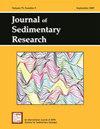Maastrichtian atmospheric pCO2 and climatic reconstruction from carbonate paleosols of the Marília Formation (southeastern Brazil)
IF 2.1
4区 地球科学
Q1 GEOLOGY
引用次数: 2
Abstract
Paleosols are the product of ancient physical, chemical, and biological processes on the Earth's surface and, as such, may record information that can be used to reconstruct the paleoatmospheric and paleoenvironmental conditions under which they formed. In Brazilian continental sedimentary successions, few studies using ancient soils have focused on the relationship between paleopedogenesis and paleoclimate. The Marilia Formation is a 160-m-thick section of the Bauru Basin in which ∼ 66% of the deposits show some evidence of pedogenic modification as paleosols. In this paper, paleosol profiles in the Marilia Formation containing thick calcrete intervals are described and attributed to three pedotypes: Avencas, Monte Alto, and Garça. Macro and microscopic pedogenic features of each pedotype are described in detail. Moreover, the analysis of clay mineralogy, whole-rock geochemistry, and stable-isotope composition are used to define pedogenic processes, paleoclimate proxies, and atmospheric pCO2 estimates. The Avencas pedotype is composed of six polygenetic profiles with different phases of carbonate precipitation, clay illuviation, and biogenic actions. The Monte Alto pedotype is moderately developed and composed of calcic horizons formed mainly by rhizoliths, with higher degrees of calcification and oxidation compared to Avencas profiles. The Garça pedotype is well developed with five polygenetic profiles presenting high carbonate content and low accumulation of clay minerals (CIA-K) and leaching. Estimates of paleoprecipitation and paleotemperature from the studied paleosols using climofunctions of molar ratio of base to alumina, depth of carbonate accumulation, salinization, oxygen composition, and paleosol weathering index proxy (PWI) show values ranging from 242 to 718 mm/yr and 11° to 14°, respectively. Climofunction values suggest a paleoclimate of semiarid to subhumid during deposition of the Marília Formation. The climate data also suggests that during the Maastrichtian, the Bauru Basin was geographically within the Southern Hot Arid Belt zone, though showing strong influence of the lower latitudinal Equatorial Humid belt. Furthermore, atmospheric pCO2 values calculated from pedogenic carbonates may correlate with a cooling interval during the latest Maastrichtian (68.5–66.25 My).巴西东南部Marília组碳酸盐古土壤的马斯特里赫特大气pCO2和气候重建
古土壤是地球表面古代物理、化学和生物过程的产物,因此,古土壤可能记录的信息可用于重建它们形成时的古大气和古环境条件。在巴西陆相沉积序列中,利用古土壤研究古成岩作用与古气候关系的研究较少。Marilia组是Bauru盆地的一个160米厚的剖面,其中约66%的沉积物显示出一些成土改造的证据。本文描述了含厚钙质层的Marilia组古土壤剖面,并将其归为Avencas、Monte Alto和gara三种土壤类型。详细描述了各型的宏观和微观成土特征。此外,还利用粘土矿物学、全岩地球化学和稳定同位素组成分析来定义成土过程、古气候代用物和大气pCO2估算。Avencas型由6个多成因剖面组成,具有不同阶段的碳酸盐沉积、粘土照明和生物成因作用。Monte Alto型发育适中,由主要由根状石形成的钙层组成,与Avencas剖面相比,钙化和氧化程度更高。gara型发育,有5条多成因剖面,碳酸盐含量高,粘土矿物(CIA-K)富集少,浸出少。利用碱与氧化铝摩尔比、碳酸盐堆积深度、盐渍化、氧组成和古土壤风化指数代理(PWI)等气候函数估算古土壤的古降水和古地温分别在242 ~ 718 mm/yr和11°~ 14°之间。气候函数值表明Marília组沉积时期为半干旱至半湿润的古气候。气候数据还表明,在马斯特里赫特时期,尽管受到低纬度赤道湿润带的强烈影响,但在地理上,Bauru盆地处于南部热干旱带内。此外,由成土碳酸盐计算的大气pCO2值可能与最新马斯特里赫特期(68.5-66.25 m)的冷却间隔有关。
本文章由计算机程序翻译,如有差异,请以英文原文为准。
求助全文
约1分钟内获得全文
求助全文
来源期刊
CiteScore
3.80
自引率
5.00%
发文量
50
审稿时长
3 months
期刊介绍:
The journal is broad and international in scope and welcomes contributions that further the fundamental understanding of sedimentary processes, the origin of sedimentary deposits, the workings of sedimentary systems, and the records of earth history contained within sedimentary rocks.

 求助内容:
求助内容: 应助结果提醒方式:
应助结果提醒方式:


